by Margaret Sgarra, contemporary art curator
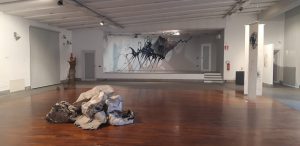
Born in Monza and raised in Biella among looms and yarns, Barbara Pavan is a curator and art critic specialized in fiber art. The passion for the yarn has led her to design and curate exhibitions, art projects, catalogs and thematic blogs, thus becoming a reference point for textile expressive forms.
Although fiber art is an artistic current that in recent years has found particular response both in Italy and abroad, it hasn’t entered the common imagination yet. In fact, it is often confused by non-experts with craftsmanship. How would you explain the difference between these two worlds?
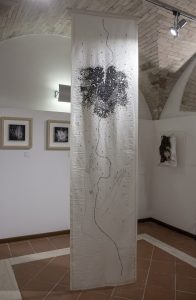
It is very complicated to answer your question in an exhaustive manner, which derives from a broader one, namely: what is art? In the case of languages such as those attributable to techniques or textile materials, it becomes even more complex to remove the works from the labeling of the artisan sphere. Let me be clear, mine is not a judgment of greater or lesser value between art, craftsmanship or design, but only the observation that they belong to different creative paths. One of the discriminating factors, I could tell you, is the function, which instead is lacking in the work of art. But it is really moving along a dangerous slope, because the affirmation is neither absolute nor reversible. Not all framed and hung embroidery works, for example, is art. But, above all, not all textile products that are not used for something in particular are. In reality, the factors that identify a work of art are innumerable and regardless of which medium is used. Precisely because I believe that fiber art is a language like any other in the contemporary field, I suggest applying the same tools we use to evaluate any other work – painting, sculpture, photography, installation, video, etc. – which we recognize as artistic.
When did you get interested in fiber art and what prompted you to get in touch with this type of art?
The interest in the textile medium as an expressive language has always fascinated me. Often labeled as ‘feminine’, but instead I have always perceived the ‘feminist’ figure. Needle and thread have been the tools of generations of women who have used them to express a minimum of creativity, a minimum of freedom, a minimum of activity freed from permeating male control. I grew up among carpets with their immense and ancestral layered heritage of decorations and symbols. And I have lived for a long time in an area with an important tradition of textile excellence that has forged places, culture and history. Fiber art was in my DNA, in my professional destiny, I could not escape it.
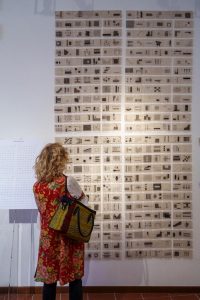
Nowadays, the number of aspiring artists is ever increasing. This is partly dictated by the desire to express oneself through artistic languages, and by the search for visibility, fame and success. Furthermore, a radical increase in courses (not just of universities), laboratories, workshops dedicated to artistic practices should be noted. In this context, how do you select the artists to collaborate with?
I don’t have a single parameter. However, I have to be convinced that they have something to express, and that what they shape is art. I am interested in understanding what their research, their experimentation, their poetics are and that all this is authentic, honest. Each artist I collaborate with is always an opportunity for personal growth and mutual comparison for me. I am curious to discover talents or works that I didn’t know. This allows me to “feed” myself professionally but also humanly. It makes sense of my work.
Do you have any advice to give to those who want to take this path?
I do not know. It depends on everyone’s expectations, talent and skills. I apply about five ‘instructions’ to myself: work, engage, experiment, study and be curious. Expectations that in the end, I am still convinced, pay off. Then of course, it’s not that a little luck doesn’t help. Above all, it is necessary to carefully evaluate the options you choose, weigh the pros and cons. Opportunities are not always what they seem in the long term, and it is not certain that an obstacle does not lead us to a necessary and saving detour. You have to know how to catch the right train at the right time. And this is a great challenge.
You recently opened the exhibition Appunti sul nostro tempo in the spaces of the Embroidery and Textile Museum in Valtopina (PG). Can you tell us about this project?
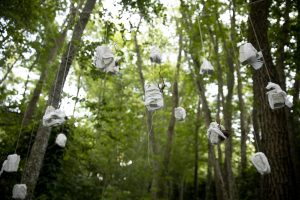
It is an international exhibition in which twenty-five artists from fifteen different countries proposed works created through embroidery. Inaugurated as part of the 20th Embroidery Exhibition, I wanted it to be an opportunity to bring the public used to understanding this practice as feminine and artisanal, precisely to its dimension as a language of contemporary art. It is a path that winds through the museum spaces in dialogue with the permanent collection, and that investigates social, political, personal and collective issues of our time: from war to propaganda, from civil rights to disease, from the environment to the value of identity. The opening days allowed me to meet and guide the public in visits, and confirmed the expressive power of this medium capable of reaching a wide audience, giving voice to reflections on complex themes. Embroidery is rooted in the lives of many, it evokes childhood memories of family and domestic skills of grandmothers, mothers and aunts, and therefore knows how to communicate even on an emotional level less reachable by other languages.
In addition to being a curator and art critic, you also collaborate with ARTEMORBIDA Textile Arts Magazine, where you talk about textile art through interviews with artists, reviews of exhibitions and events and more. Tell us about this editorial experience.
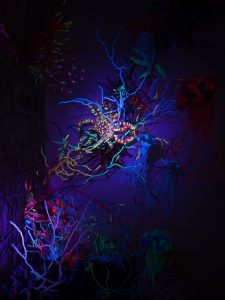
The collaboration with ArteMorbida allows me to combine two passions of which I have made a profession: writing and fiber art. The magazine, which today has a circulation in all countries and is an international point of reference in this area, was born from the courage of a publisher with whom I share the same textile passion. In just two years it has experienced an exponential growth thanks to a team, largely female, tireless and highly motivated. It is a continuously expanding project and an indispensable tool now for those who want to approach this sector or deepen their knowledge.
What are your next projects and where will they take you?
In the short term, for ArteMorbida which is the media partner and organizer, I will curate the Salone Italia for the celebration of the 25th year since the founding of the WTA World Textile Art with a first exhibition at the Textile Museum of Busto Arsizio in October, and a widespread project in Bergamo in January and February, partly included in the events of Bergamo and Brescia Capitali della Cultura.